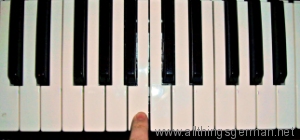German not only has a few extra letters of the alphabet (ä, ö, ü, Ä, Ö, Ü and ß), it also has different names for musical notes as well.
This was something I first discovered many years ago whilst visiting a school in Willich near Düsseldorf, when spotted something labelled as “H” in the music room.
It came as a shock, as I had always assumed that any country using the standard 5-stave notation also called the notes by the letters A to G as well. But Germany does not, it uses A to H.
My question back then was “what is H?” And the answer is quite simple really: it’s B.

But in the German system this is also a ‘B’ – and this is the B flat.
Other notes have their own names as well. When referring to a sharp, the note below has an ‘is’ attached to it. F sharp (F#) is therefore ‘Fis’, C sharp (C#) is ‘Cis’.
For flats, an ‘es’ is added to the note above, so D flat (Db) is ‘Des’, although E flat (Eb) becomes ‘Es’ and A flat (Ab) becomes ‘As’.
But why is ‘H’ so an exception? Well, according to Wikipedia this is a result of changes made to musical notation in the 12th Century. At this time there were two ways to write a note on the stave, with the angle of the lines denoting a note to be played at the normal pitch or a half-pitch deeper.
These two forms of writing a note later evolved into the sharp and flat signs that we know today, but in the case of B something special happened. The sign of B-flat looked so much like a ‘b’ that it was written simply as a single letter. With the lines slanting in the other direction, for a normal ‘B’, the note resembled an ‘H’ and when printed music arrived it continued to be referred to as such.
Hence a scale in C major contains the notes C-D-E-F-G-A-H-C’, a scale in F major contains F-G-A-B-C-D-E-F’.
Another musical difference is that whilst it may be common in English speaking countries to tune an instrument to “middle C”, German orchestras prefer to use “Kammerton A” which is exactly 440Hz and the A above middle C.
In Austria, you can even tune an instrument using your telephone. To do this, you dial special telephone number and you can hear a 440Hz tone. This even works from outside the country, so if you want to try it for yourself, dial +43 1 1507 – but remember that international call rates will apply, so a tuning fork might be cheaper!


